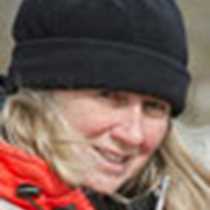Marguerite Bay, Antarctica
Bipolar took on a new meaning yesterday as we crossed the Antarctic Circle. A number of our shipboard family can now claim to have been to the extremes of the earth in both southern and northern regions. More milestones were piled on today as we set foot on the Antarctic continent, the seventh continent for many. But maybe the most significant of accomplishments is intricately tied to just where it was we contacted these southern shores.
The day started like any other when you wake up in territory little visited by man. Thrilling, beautiful, awe-inspiring, words hardly seem to describe the feelings we held inside. Dramatic dark skies were the backdrop for massive sculpted bergs floating on almost mirror calm seas. (By the way, the sun doesn't set here right now so the skies weren't dark from lack of light, just from a pretty impressive cloud cover lit from all directions by reflections bouncing from snow and ice.) Adding a splash of yellow and red to this scene seemed to be the right thing to do. A fleet of kayaks paddled forth. Their strokes were silent but they need not have been for even an engine's roar would have been masked by the snapping of bergy-seltzer and the thundering rumbles of a nearby glacier. Stonington Island was the base of operations. Here, not forty meters apart, slightly less than 70 years ago British and American research teams mushed their dog-sleds up the glacier tongue or landed their planes on what might have been considered a somewhat risky runway. This river of ice has greatly changed since then and no soul would dare venture near its crumbling steep sided face today. From the air now it must look like a nightmare of a jigsaw puzzle, irregular shaped seracs edged by deep blue fractures.
Until this day, Stonington was the furthest south the National Geographic Endeavour had ventured. But a combination of inviting weather and adventuresome spirit sent us out exploring further. There were rumors of an Adelie penguin colony somewhere near Red Rock Ridge, on the continent. Zodiacs danced between the growlers, bergy-bits and bergs and there on a polished rocky ridge were hundreds of birds, busily tending their fat and fluffy chicks. Up and over snowy slopes they marched from one bay to another, detouring around somnolent seals and ducking as testy terns proclaimed which terrain they claimed. Quite possibly no one had visited this colony for forty years and data collected today should prove to be valuable in monitoring this species in the region.
And where was this spot? Sixty-eight degrees, seventeen and a half minutes south! Our furthest south is something to brag about.
Bipolar took on a new meaning yesterday as we crossed the Antarctic Circle. A number of our shipboard family can now claim to have been to the extremes of the earth in both southern and northern regions. More milestones were piled on today as we set foot on the Antarctic continent, the seventh continent for many. But maybe the most significant of accomplishments is intricately tied to just where it was we contacted these southern shores.
The day started like any other when you wake up in territory little visited by man. Thrilling, beautiful, awe-inspiring, words hardly seem to describe the feelings we held inside. Dramatic dark skies were the backdrop for massive sculpted bergs floating on almost mirror calm seas. (By the way, the sun doesn't set here right now so the skies weren't dark from lack of light, just from a pretty impressive cloud cover lit from all directions by reflections bouncing from snow and ice.) Adding a splash of yellow and red to this scene seemed to be the right thing to do. A fleet of kayaks paddled forth. Their strokes were silent but they need not have been for even an engine's roar would have been masked by the snapping of bergy-seltzer and the thundering rumbles of a nearby glacier. Stonington Island was the base of operations. Here, not forty meters apart, slightly less than 70 years ago British and American research teams mushed their dog-sleds up the glacier tongue or landed their planes on what might have been considered a somewhat risky runway. This river of ice has greatly changed since then and no soul would dare venture near its crumbling steep sided face today. From the air now it must look like a nightmare of a jigsaw puzzle, irregular shaped seracs edged by deep blue fractures.
Until this day, Stonington was the furthest south the National Geographic Endeavour had ventured. But a combination of inviting weather and adventuresome spirit sent us out exploring further. There were rumors of an Adelie penguin colony somewhere near Red Rock Ridge, on the continent. Zodiacs danced between the growlers, bergy-bits and bergs and there on a polished rocky ridge were hundreds of birds, busily tending their fat and fluffy chicks. Up and over snowy slopes they marched from one bay to another, detouring around somnolent seals and ducking as testy terns proclaimed which terrain they claimed. Quite possibly no one had visited this colony for forty years and data collected today should prove to be valuable in monitoring this species in the region.
And where was this spot? Sixty-eight degrees, seventeen and a half minutes south! Our furthest south is something to brag about.




